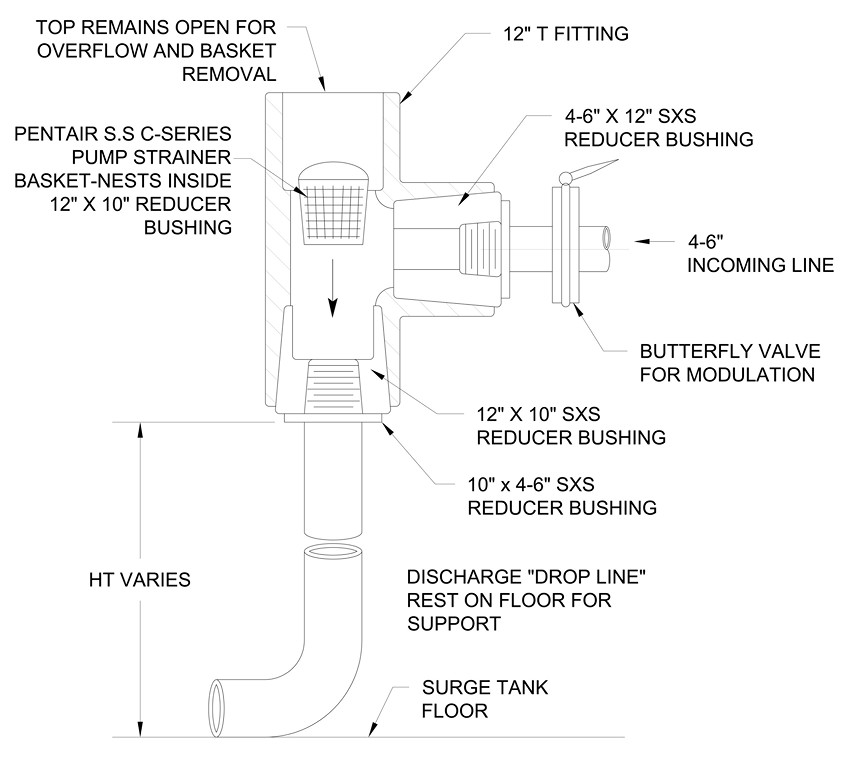Keeping It Clean

With water-in-transit effects becoming more and more popular, increasing numbers of watershapers find themselves in need of external tanks to give these systems the surge capacity they need to function at peak efficiency. Here, Paolo Benedetti discusses his preferences when it comes to setting up his surge tanks – and defines a number of issues designers and builders should consider in making them both reliable and serviceable.
As a rule, the surge tanks used in conjunction with water-in-transit effects take one of two forms. A number of watershapers I know use prefabricated plastic tanks that are delivered to a site, ready for installation. I take the alternative path, custom-making my own out of shotcrete at the same time I shoot my shells.
Whichever method is used, there’s an issue too many builders overlook: In time, debris and other material will collect in these tanks and eventually become problematic. As someone who’s spent plenty of time servicing pools, I am keenly aware of how important it is to make these remote or detached tanks both accessible and fully serviceable.
In addition, I’m aware that relatively few service companies will routinely drain, rinse out and vacuum these tanks: What’s out of sight, it seems, all too often slips out of mind as well. This is why I take no chances and have done all I can to create surge tanks for my water-in-transit systems that are as self-cleaning as possible while also ensuring that, when direct service is needed, the tanks are as accessible as I can make them.
DOWN THE DRAIN
The first self-cleaning measure I use with my surge tanks involves installing main drains in all of them. (This is something I’ve always done, and it’s one of the reasons I make my own tanks: It can be very difficult to install a main-drain system with a prefabricated plastic tank.)
| Here’s a schematic of the debris-collection system I use in surge tanks. The basket slides down into the fitting to a point below the inlet and can easily be removed through the top, which remains open to allow for overflow in case the basket becomes clogged. |
As always, I work with a hydraulically balanced approach, installing split drains with one in the center of the floor and the other on one of the walls. I do so because I’ve observed that debris settles in the center of these tanks as water circulates around the perimeter. The center drain collects this material, while the wall drain pulls additional debris from the circulating water before it has a chance to settle.
To establish this circulation pattern, we use physics and a bit of mechanical assistance courtesy of strategic placement of the inlet drop-line and the auto-fill inlet at opposite ends of the tank. Knowing that water above the equator circulates clockwise (as seen from above), we give natural science a boost by placing these inlets so they effectively “go with the flow” and help in maintaining a robust clockwise pattern.
This is easily accomplished by placing elbows on the bottom of drop lines so we can direct the flow where we want it to go. Similarly, we position the auto-fill inlet just an inch or two above the floor, stubbing it into the tank in such a way that it is directed into the flow pattern as well whenever the tank requires topping off.
As for the drain covers, I don’t use the normal grate-style versions, either flat or anti-vortex. With these grates, debris will collect on top and the water’s flow will be impeded or even obstructed. Instead, I prefer to use raised-platform-style drain covers that are open around the perimeter. The surfaces of these anti-vortex covers are solid, supported on posts at the corners and sides.
The ones I use have half- to three-quarter-inch gaps at the sides that easily allow debris to slip under the cover for passage to the sump. (We use these same covers in open surge tanks – the troughs of vanishing-edge system, for example – for the same reasons.)
INTERNAL FILTRATION
Another self-cleaning system I install is designed to minimize the introduction of large foreign matter (leaves, twigs, chewing gum, pieces of pool toys and such) – and the best part of it is that I assemble it myself using off-the-shelf components.
These fixtures are large, so the incoming lines must be high up on the wall so the tank’s operating level remains below the debris-collection basket that makes the system tick. (The alternative, of course, is making the tank deeper. Either way, using such a pre-filtering system requires some planning.)
| The strainer basket sits perfectly atop a 10-inch reducer bushing (at right) that we’ll place at the base of the 12-inch T fitting (below). Once installed, this system collects all sorts of debris that would otherwise reach the main body of the surge tank and become a maintenance hassle. |
The housing that carries the filter basket is a 12-inch-diameter, schedule 40 tee fitting. The “through leg” of the tee is positioned vertically, while the side leg of the tee is stepped down to the diameter of the inlet line and attached to that line. The top of the tee is left open and retains its full interior diameter.
 On the bottom of the through leg, we install a slip-slip reducer bushing to take the diameter down from 12 inches to ten inches. This is important, because this new “lip” within the tee will cradle the strainer basket. Below the tee, the 10-inch opening of the bushing is reduced down to whatever size drop line you want to use and extended to the floor (where the abovementioned elbow fitting directs the flow as desired).
On the bottom of the through leg, we install a slip-slip reducer bushing to take the diameter down from 12 inches to ten inches. This is important, because this new “lip” within the tee will cradle the strainer basket. Below the tee, the 10-inch opening of the bushing is reduced down to whatever size drop line you want to use and extended to the floor (where the abovementioned elbow fitting directs the flow as desired).
In our surge tanks, we allow the elbow to rest on the floor, thus letting it support some of the weight of the plumbing components stacked above it. As for the strainer basket, I have developed a preference for the stainless steel hair-and-lint-trap baskets Pentair (Sanford, N.C.) uses with its C-Series bronze pumps: These baskets rest perfectly within the taper of the reducer bushing.
The bronze upper rim of the basket sits below the side inlet of the tee and is easily removed through the open top of the 12-inch through leg for quick disposal of any collected debris. If the homeowners or their technician fail to clear the basket, no great harm is done: Incoming water will simply “boil over” and flow out of the open top of the tee.
This grouping of parts and fittings is easy to assemble at any good pool- or irrigation-supply house and costs my clients about $1,000 in all. What I like most about it is that the system is simple, reliable and requires almost nothing by way of custom fabrication.
PERSONAL ACCESS
In time, even the best designed of all self-cleaning surge tanks will need some human intervention to keep things running smoothly. As a result, I build two access ports into the tops of my tanks – one large enough for a person and the other sized to allow for easy removal of the debris basket.
To make things as easy as can be, we position the larger port close to one of the walls and install “ladder rungs” below it during construction. We make the rungs from Grade 60 #5 or #6 rebar – either epoxy-coated or stainless steel – stripping the ends of epoxy-coated bars so we can bond them to the tank’s reinforcing steel.
Inside the tank, we include a port in the floor of the tank that we tie to the pool’s vacuum system. To make things even more workable, we’ll install a light or two in the tank if the pool features either fiberoptic or low-voltage lighting – whatever we can do, in other words, to encourage those responsible for maintaining the watershape to get the whole job done.
Through the years, this attention to detail has clearly paid off: We’ve found that the self-cleaning features have gone a long way toward minimizing the maintenance needs of our surge tanks. Add to that the care we take in setting things up to make it easy for technicians to get inside these tanks and clean them quickly and easily – and for our clients to kick back and enjoy the special atmosphere their water-in-transit systems are meant to provide.
Paolo Benedetti is principal at Aquatic Technology Pool & Spa, a design/build firm based in Morgan Hill, Calif. He may be reached at [email protected].












